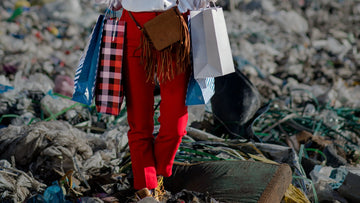Fashion is an ever-evolving industry, setting trends, defining styles, and influencing consumer behaviour worldwide. However, amidst the glitz and glamour, lies a darker reality - the significant environmental and social impact caused by the fashion industry's production and consumption patterns. This blog delves into the intricate relationship between fashion and waste, shedding light on the environmental consequences and exploring potential solutions.
The Environmental Toll of Fast Fashion
Fast fashion, characterized by rapid production cycles and low-cost garments, has revolutionized the way we consume clothing. This model encourages frequent purchases of inexpensive clothing items, leading to a culture of disposability. However, this mass production comes at a steep environmental cost. According to the United Nations Environment Programme (UNEP), the fashion industry is responsible for approximately 10% of global carbon emissions, more than international flights and maritime shipping combined.
Beyond carbon emissions, fast fashion contributes to other forms of environmental degradation. Textile production involves the use of vast amounts of water, chemicals, energy, and plastic. Waste water from textile dyeing and treatment processes often contains hazardous substances, polluting waterways and harming ecosystems. Additionally, the extraction of raw materials, such as cotton, the cutting of forests, and synthetic fibers, leads to habitat destruction, the creation of wastelands, and biodiversity loss.
Waste Along the Supply Chain
At every stage of the fashion supply chain, from textile production to garment manufacturing and distribution, waste is generated. Textile production, which involves resource-intensive processes like dyeing and finishing, contributes to water pollution and depletion. Furthermore, large quantities of fabric are discarded during cutting and sewing processes, adding to the industry's waste footprint. Garment manufacturing also generates significant waste, including offcuts, scraps, and unused materials. According to the Waste and Resources Action Programme (WRAP), it is estimated that around 16% of fabric intended for clothing ends up as waste on the factory floor. Moreover, the fashion industry's reliance on plastic packaging for shipping and retail exacerbates the problem of plastic pollution.
The Rise of Textile Waste
The disposal of clothing presents a significant challenge. As fashion trends change rapidly, garments are often discarded after only a few uses, leading to a surge in textile waste. The phenomenon of "throwaway fashion" contributes to the proliferation of landfills and incinerators, further exacerbating environmental problems. The Ellen MacArthur Foundation estimates that the equivalent of one garbage truck of textiles is wasted every second globally. Much of this waste ends up in landfills or incineration facilities, where it can take hundreds of years to decompose or release harmful pollutants into the air and soil. Furthermore, the production of new clothing items to meet consumer demand perpetuates the cycle of waste generation.
Addressing the Issue:
Embracing Sustainable Fashion
Sustainable fashion brands (you must do your research to make sure the brands you support are truly sustainable and is not greenwashing). How do you identify these brands:
Look for the following:
-
These brands make their designs in earth-friendly materials, such as organic cotton (GOT certified, BCI), textiles from closed-loop production of organic wastes, Linen, Hemp, recycled cotton/linen, Tencel (but be mindful that it is from the right wood source and huge forests are not cut down to produce them), and Recycled fabrics except the exceptions below.
-
They do not use polyester, recycled polyester, Nylon, or fabrics made out of recycled plastic as these end up creating microplastic in our oceans and soil.
-
Minimal collections a year and Their collections are NOT mass-produced.
-
They focus on design and quality.
Circular Fashion
Circular fashion is a key concept within sustainable fashion, focusing on creating a closed-loop system where clothing is designed to be reused, repaired, or recycled. By extending the lifespan of garments through repair and refurbishment, and by recycling materials to create new clothing, circular fashion aims to minimize waste and reduce the industry's reliance on virgin resources
Other Initiatives
In addition to sustainable and circular fashion, various other initiatives are contributing to the reduction of fashion waste. These include clothing rental services, second-hand shopping platforms, and clothing swaps. By promoting alternatives to regular retail, these initiatives encourage consumers to adopt more sustainable consumption habits and reduce their environmental impact. However, the most effective choice is moderation in consumption.
Conclusion
Exploring the interplay between fashion and waste is complex, driven by consumer demand for cheap, trendy clothing and the industry's pursuit of profit. However, by embracing a minimalistic lifestyle, sustainable fashion practices, and rethinking our approach to clothing consumption, we can mitigate the environmental impact of the fashion industry and pave the way for a more sustainable future.
In the end, fashion isn't just about looking good - it's about feeling good, knowing that the clothes we wear are made with care for the planet and its people.
References:
United Nations Environment Programme (UNEP) – Fashion
Waste and Resources Action Programme (WRAP) – Textiles
Ellen MacArthur Foundation - A New Textiles Economy
Forbes - How Sustainable Fashion is Addressing Its Waste Problem





